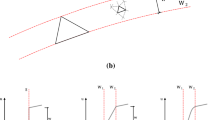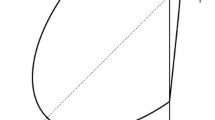Abstract
In-plane cyclic loading of masonry walls induces a complex failure pattern composed of multiple diagonal shear cracks, as well as flexural cracks. The realistic modelling of such induced localized cracking necessitates the use of costly direct numerical simulations with detailed information on both the properties and geometry of masonry components. On the contrary, computationally efficient macro-models using standard smeared-crack approaches often result in a poor representation of fracture in the simulated material, not properly localized and biased by the finite element mesh orientation. This work proposes a possible remedy to these drawbacks of macro-models through the use of a crack-tracking algorithm. The macro-modelling approach results in an affordable computational cost, while the tracking algorithm aids the mesh-bias independent and localized representation of cracking. A novel methodology is presented that allows the simulation of intersecting and multi-directional cracks using tracking algorithms. This development extends the use of localized crack approaches using tracking algorithms to a wider field of applications exhibiting multiple, arbitrary and interacting cracking. The paper presents also a novel formulation including into an orthotropic damage model the description of irreversible deformations under shear loading. The proposed approach is calibrated through the comparison with an experimental test on a masonry shear wall against in-plane cyclic loading.














Similar content being viewed by others
References
Huerta S (2008) The analysis of masonry architecture: a historical approach. Archit Sci Rev 51(4):297–328
Roca P, Cervera M, Gariup G, Pelà L (2010) Structural analysis of masonry historical constructions. Classical and advanced approaches. Arch Comput Methods Eng 17:299–325
Theodossopoulos D, Sinha B (2013) A review of analytical methods in the current design processes and assessment of performance of masonry structures. Constr Build Mater 41:990–1001
Addessi D, Marfia S, Sacco E, Toti J (2014) Modeling approaches for masonry structures. Open Civ Eng J 2:288–300
Orduña A, Lourenço PB (2003) Cap model for limit analysis and strengthening of masonry structures. J Struct Eng 129(10):1367–1375
Block P, Ciblac T, Ochsendorf J (2006) Real-time limit analysis of vaulted masonry buildings. Comput Struct 84:1841–1852
Gilbert M, Casapulla C, Ahmed H (2006) Limit analysis of masonry block structures with non-associative frictional joints using linear programming. Comput Struct 84:873–887
Milani G, Lourenço P, Tralli A (2006) Homogenised limit analysis of masonry walls, part I: failure surfaces. Comput Struct 84:166–180
Roca P, Molins C, Marí AR (2005) Strength capacity of masonry wall structures by the equivalent frame method. J Struct Eng 131(10):1601–1610
Lagomarsino S, Penna A, Galasco A, Cattari S (2013) TREMURI program: an equivalent frame model for the nonlinear seismic analysis of masonry buildings. Eng Struct 56:1787–1799
Siano R, Sepe V, Camata G, Spacone E, Roca P, Pelà L (2017) Analysis of the performance in the linear field of equivalent-frame models for regular and irregular masonry walls. Eng Struct 145:190–2010
Endo Y, Pelà L, Roca P, Porto F, Modena C (2015) Comparison of seismic analysis methods applied to a historical church struck by 2009 L ’ Aquila earthquake. Bull Earthq Eng 13:3749–3778
Saloustros S, Pelà L, Roca P, Portal J (2014) Numerical analysis of structural damage in the church of the Poblet monastery. Eng Fail Anal 48:41–61
Pelà L, Cervera M, Roca P (2013) An orthotropic damage model for the analysis of masonry structures. Constr Build Mater 41:957–967
Lourenço PB, Rots JG (1997) Multisurface interface model for analysis of masonry structures. J Eng Mech 123(7):660–668
Macorini L, Izzuddin BA (2011) A non-linear interface element for 3D mesoscale analysis of brick-masonry structures. Int J Numer Methods Eng 85:1584–1608
Massart TJ, Peerlings RHJ, Geers MGD (2007) An enhanced multi-scale approach for masonry wall computations with localization of damage. Int J Numer Methods Eng 69:1022–1059
Addessi D, Sacco E (2012) A multi-scale enriched model for the analysis of masonry panels. Int J Solids Struct 49(6):865–880
Petracca M, Pelà L, Rossi R, Oller S, Camata G, Spacone E (2017) Multiscale computational first order homogenization of thick shells for the analysis of out-of-plane loaded masonry walls. Comput Methods Appl Mech Eng 315:273–301
Clemente R (2006) Análysis estructural de edificios históricos mediante modelos localizados de fisuración. Ph.d. thesis, Universitat Politècnica de Catalunya
Pelà L (2009) Continuum damage model for nonlinear analysis of masonry structures. Ph.d. thesis, Universitat Politècnica de Catalunya
Cervera M, Pelà L, Clemente R, Roca P (2010) A crack-tracking technique for localized damage in quasi-brittle materials. Eng Fract Mech 77(13):2431–2450
Roca P, Cervera M, Pelà L, Clemente R, Chiumenti M (2013) Continuum FE models for the analysis of Mallorca Cathedral. Eng Struct 46:653–670
Pelà L, Cervera M, Oller S, Chiumenti M (2014) A localized mapped damage model for orthotropic materials. Eng Fract Mech 124–125:196–216
Cervera M, Chiumenti M (2006) Smeared crack approach: back to the original track. Int J Numer Anal Methods Geomech 30(12):1173–1199
Slobbe A, Hendriks M, Rots J (2014) Smoothing the propagation of smeared cracks. Eng Fract Mech 132:147–168
Oliver J, Huespe AE (2004) Continuum approach to material failure in strong discontinuity settings. Comput Methods Appl Mech Eng 193(30–32):3195–3220
Meschke G, Dumstorff P (2007) Energy-based modeling of cohesive and cohesionless cracks via X-FEM. Comput Methods Appl Mech Eng 196(21–24):2338–2357
Dias-Da-Costa D, Alfaiate J, Sluys LJ, Júlio E (2010) A comparative study on the modelling of discontinuous fracture by means of enriched nodal and element techniques and interface elements. Int J Fract 161(1):97–119
Zhang Y, Lackner R, Zeiml M, Mang H a (2015) Strong discontinuity embedded approach with standard SOS formulation: element formulation, energy-based crack-tracking strategy, and validations. Comput Methods Appl Mech Eng 287:335–366
Saloustros S, Pelà L, Cervera M (2015) A crack-tracking technique for localized cohesive-frictional damage. Eng Fract Mech 150:96–114
Saloustros S, Pelà L, Cervera M, Roca P (2016) Finite element modelling of internal and multiple localized cracks. Comput Mech 59(2):299–316
Faria R, Oliver J (1993) A rate dependent plastic-damage constitutive model for large scale computations in concrete structures. CIMNE
Cervera M, Oliver J, Faria R (1995) Seismic evaluation of concrete dams via continuum damage models. Earthq Eng Struct Dyn 24(9):1225–1245
Faria R, Oliver J, Cervera M (2004) Modeling material failure in concrete structures under cyclic actions. J Struct Eng 130:1997–2005
Roca P, Cervera M, Pelà L, Clemente R, Chiumenti M (2012) Viscoelasticity and damage model for creep behavior of historical masonry Structures. Open Civ Eng J 6:188–199
Pelà L, Bourgeois J, Roca P, Cervera M, Chiumenti M (2016) Analysis of the effect of provisional ties on the construction and current deformation of Mallorca Cathedral. Int J Archit Herit 10:418–437
Faria R, Oliver J, Cervera M (1998) A strain-based plastic viscous-damage model for massive concrete structures. Int J Solids Struct 35:1533–1558
Petracca M, Pelà L, Rossi R, Oller S, Camata G, Spacone E (2016) Regularization of first order computational homogenization for multiscale analysis of masonry structures. Comput Mech 57:257–276
Lubliner J, Oliver J, Oller S, Oñate E (1989) A plastic-damage model for concrete. Int J Solids Struct 25(3):299–326
Petracca M, Pelà L, Rossi R, Zaghi S, Camata G, Spacone E (2017) Micro-scale continuous and discrete numerical models for nonlinear analysis of masonry shear walls. Constr Build Mater, (in press)
Oliver J, Cervera M, Oller S, Lubliner J (1990) Isotropic damage models and smeared crack analysis of concrete. In: Proceedings of SCI-C computer aided analysis and design of concrete structures, pp. 945–957
Bazant Z, Oh B (1983) Crack band theory for fracture of concrete. Mater Struct 16:155–177
Cervera M, Chiumenti M (2006) Mesh objective tensile cracking via a local continuum damage model and a crack tracking technique. Comput Methods Appl Mech Eng 196(1–3):304–320
Cervera M (2003) Viscoelasticity and Rate-dependent Continuum Damage Models. Monography N-79. tech. rep., Barcelona
Rabczuk T, Bordas S, Zi G (2010) On three-dimensional modelling of crack growth using partition of unity methods. Comput Struct 88(23–24):1391–1411
Song J-H, Belytschko T (2009) Cracking node method for dynamic fracture with finite elements. Int J Numer Methods Eng 77:360–385
de Borst R, Nauta P (1985) Non-orthogonal cracks in a smeared finite element model. Eng Comput 2(1):35–46
Anthoine A, Magenes G, Magonette G (1994) Shear compression tensting and analysis of brick masonry walls. In: 10th European conference on earthquake engineering, (Vienna), pp. 1657–1662
Magenes G, Calvi GM (1997) In-plane seismic response of brick masonry walls. Earthq Eng Struct Dyn 26:1091–1112
Binda L, Mirabella Roberti G, Tiraboschi C, Abbaneo S (1994) Measuring masonry material properties. U.S.-Italy Workshop on Guidelines for Seismic Evaluation and Rehabilitation of Unreinforced Masonry Buildings, pp. 326–347
COMET (2016) Coupled mechanical and thermal analysis. http://www.cimne.com/comet/
GiD (2016) The personal pre and post-processor. http://www.gidhome.com/
Saloustros S, Pelà L, Cervera M, Roca P (2017) An enhanced finite element macro-model for the realistic simulation of localized cracks in masonry structures: a large-scale application. Int J Archit Herit. doi:10.1080/15583058.2017.1323245
Acknowledgements
This research has received the financial support from the MINECO (Ministerio de Economia y Competitividad of the Spanish Government) and the ERDF (European Regional Development Fund) through the MULTIMAS project (Multiscale techniques for the experimental and numerical analysis of the reliability of masonry structures, ref. num. BIA2015-63882-P).
Author information
Authors and Affiliations
Corresponding author
Ethics declarations
Conflict of interest
The authors declare that they have no conflict of interest.
Appendix
Appendix
The rate of the mechanical dissipation \(\gamma\) of the continuum damage model presented in Sect. 2 is [33]
where \(\psi\) is the Helmholtz free energy and \(\psi _0^\pm\) elastic free energies which have the following form [33]
It is visible from Eq. (28) that the evolutions of both damage \(\dot{\gamma }^d\) and irreversible strains \(\dot{\gamma }^i\) contribute to the total dissipation energy of the solid, with each part being
The total dissipated energy per unit volume \(g_f\) is obtained as
The discrete softening parameter can be defined similarly to [44] considering an ideal uniaxial 1D compressive experiment, with a monotonic increment of the compressive strain (denoted hereafter as \(\epsilon ^e\)) from an initial unstressed state to full degradation. During the loading, and considering Eqs. (5) and (9) the stress threshold will be
In such case the dissipation due to the damage evolution is (see [44])
The contribution of the irreversible strains to the total dissipated energy can be computed considering
and
Using the above Eqs. (39c) and (40), the dissipated energy due to the evolution of the irreversible strains is
By virtue of Eqs. (36) as well as (41) and considering that the total dissipation should be equal to \(Gf^-\), the updated softening modulus is derived as
Note that for the limit case of \(\beta =1\), equation (39b) limits to \(\dot{\epsilon }^i=\dot{\epsilon }\) and consequently \(\dot{\epsilon }^e= 0\). This results in \(\Delta r = 0\), which means that there is no damage evolution and hence no softening. In that case, energy is dissipated only due to the evolution of the irreversible strains, which using equations (32), (35) and (40) will be
with \(\epsilon _0^e\) being the elastic strain at the peak strength. According to the above, the dissipation will keep increasing linearly with the increase of the strains, resembling the behaviour of a perfectly plastic material.
Rights and permissions
About this article
Cite this article
Saloustros, S., Cervera, M. & Pelà, L. Tracking multi-directional intersecting cracks in numerical modelling of masonry shear walls under cyclic loading. Meccanica 53, 1757–1776 (2018). https://doi.org/10.1007/s11012-017-0712-3
Received:
Accepted:
Published:
Issue Date:
DOI: https://doi.org/10.1007/s11012-017-0712-3




